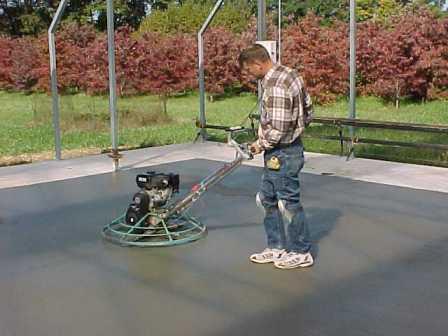Power float
A power float is a hand-operated machine used to produce a smooth, dense and level surface finish to insitu concrete beds. Power floating eliminates the time and materials needed to apply a finishing screed and is quicker and less labour-intensive process than hand trowelling.
Power floats have an electric motor or petrol engine fixed over a circular pan or skimmer which smooths concrete before hardened steel reversible metal blades rotate at up to 150 rpm over the surface to create a hardened finish.
Before power floating the concrete must be left to partially set, having been leveled and tamped. The amount of setting time necessary before power floating will depend on variables such as; air temperature, humidity, the specification of the mix and so on. A rough guide for considering when to begin power floating is when walking on the surface leaves indentations of 3-4 mm. If the concrete is too wet the machine will tear up the surface, and if it is too dry, it will not be possible to trim high spots or fill low spots effectively.
Floating usually starts at one end of the slab and moves to the other. The operator holds the float at waist-height and moves backwards so that the float removes their footprints. The speed should be slow and consistent.
Once the surface has been floated, the blades are angled to suit the concrete and achieve the specified finish. Blade angles of around 5-10 degrees are usual, but these may need to be increased after each pass over the surface.
[edit] Related articles on Designing Buildings Wiki
- Breaker.
- Cement.
- Compressed air plant.
- Concrete.
- Concrete vs. steel.
- Concreting plant.
- Laser screed.
- Screed.
- Tremie.
- Types of floor.
- Types of flooring.
[edit] External references
- Speedcrete - Power floating tips
- ‘Building Construction Handbook’ (6th ed.), CHUDLEY, R., GREENO, R., Butterworth-Heinemann (2007)
Featured articles and news
Homes England creates largest housing-led site in the North
Successful, 34 hectare land acquisition with the residential allocation now completed.
Scottish apprenticeship training proposals
General support although better accountability and transparency is sought.
The history of building regulations
A story of belated action in response to crisis.
Moisture, fire safety and emerging trends in living walls
How wet is your wall?
Current policy explained and newly published consultation by the UK and Welsh Governments.
British architecture 1919–39. Book review.
Conservation of listed prefabs in Moseley.
Energy industry calls for urgent reform.
Heritage staff wellbeing at work survey.
A five minute introduction.
50th Golden anniversary ECA Edmundson apprentice award
Showcasing the very best electrotechnical and engineering services for half a century.
Welsh government consults on HRBs and reg changes
Seeking feedback on a new regulatory regime and a broad range of issues.
CIOB Client Guide (2nd edition) March 2025
Free download covering statutory dutyholder roles under the Building Safety Act and much more.
Minister quizzed, as responsibility transfers to MHCLG and BSR publishes new building control guidance.
UK environmental regulations reform 2025
Amid wider new approaches to ensure regulators and regulation support growth.
BSRIA Statutory Compliance Inspection Checklist
BG80/2025 now significantly updated to include requirements related to important changes in legislation.























